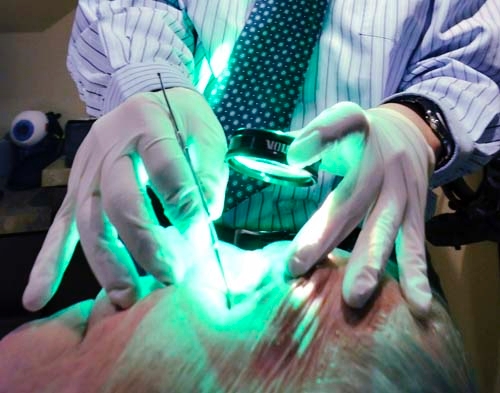Doctors give tips for ailing eyes


Specks drifting across the sky. Wispy strands and geometric shapes hovering in the air. Flashes of light seen off to the side.
If nothing else, they’re certainly the most mesmerizing symptoms of a potentially serious medical problem anyone could imagine.
But while just about everybody experiences them, floaters and flashes are nothing to take lightly. In some who have them – and just about everybody will at one point or another – flashes and floaters can be a sign that the retina of an eye has torn, and that, if it’s not treated, can lead to retinal detachment and vision loss.
Flashes and floaters are part of the same syndrome, said Dr. Kenneth Westfield, a Las Vegas ophthalmologist with Westfield Eye Center. Both involve vitreous, the clear gel that fills the inside of the eye and helps to give the eye its shape.
Over time, the vitreous gel shrinks and liquefies, pulling away from the retina – the light-sensitive tissue in the back of the eye that acts, broadly speaking, like film in a camera – in a painless process called posterior vitreous detachment or posterior vitreous separation.
As the vitreous separates from the retina, it can form pockets of fluid in the eye, said Dr. Meher Yepremyan, an ophthalmologist and retina specialist with Retina Consultants of Nevada. "What you see is the shadows of those pockets on your retina."
These are called floaters, which also can be caused by vitreous folding over on itself or tiny cells appearing in the eye.
Typically, "you see them moving in your field of vision, and sometimes when you see a plain background, like a white wall or a blue sky, you can see the floaters better," said Dr. Kwang J. Lee, an ophthalmologist and retina specialist with Nevada Retina Center. "They look like they’re in front of you, but they actually are inside your eye."
Floaters can take any shape and size, Westfield added. "Some people describe them as gnats, others seem to form shapes, but it’s all the same thing: The vitreous gets kind of pulled away and forms some kind of opacity that they see."
This shrinking and pulling away of vitreous from the retina also can cause flashes.
"The flashing lights are due to the fact that the vitreous jelly, which is glued to the retina when we are born, starts pulling away," Yepremyan said. "When it starts to pull away, it tugs on the retina, and the patient’s brain perceives it as flashing lights."
The appearance of floaters or flashes is a sign that the process of vitreous separation is occurring. Typically, this begins around middle age, Lee said, and, by around age 60, often "happens spontaneously without any external factor."
But, in some people, the process begins earlier. For example, previous eye surgery (including cataract surgery), "a high degree of nearsightedness" (because of the anatomical structure of the eye and retina in nearsighted people), degenerative diseases of the retina, conditions that can cause bleeding or inflammation inside the eye and trauma all "can cause the gel to degenerate faster and make the gel pull away from the retina at an earlier stage than would have occurred otherwise," Lee said.
The good news is that separation of vitreous from the retina usually causes no significant problems. The bad news is that, in some people, the separating vitreous can cause a tear in the retina that, left untreated, can result in the retina detaching from the back of the eye.
Fluid "starts to pass through the tear," Lee explained. "It collects under the retina and slowly pushes the retina from the (back) wall of the eye."
Yepremyan said that, for about a one-month period following the appearance of floaters or flashes, "the risk of having a torn retina or a detached retina is higher than the baseline risk. That’s the best time to see an eye doctor and get examined."
The appearance of floaters or flashes doesn’t mean that a retinal tear or detachment has occurred. But a sudden increase of floaters or the appearance of new floaters are "warning signs that maybe a tear has happened or could happen," Lee said.
Westfield said that, "90-plus percent of the time," vitreous separation is "a benign condition and eventually goes away. It’s that 1 or 2 percent who, when they have that tear, it can lead to retina detachment. That’s why people shouldn’t ignore them."
If an examination reveals that a tear has occurred, it can be repaired via laser, by using the energy of the laser to create burns around the tear. Over a period of weeks, scars will form around the tear, fusing the retina to the back of the eye and preventing fluid from seeping through the tear and under the retina.
The laser procedure is performed in the office, takes a matter of minutes and is painless, uncomfortable only to the extent of having to cope with a bright light shined into the eye and keeping the eye open for longer than is normal.
In contrast, retinal detachment requires major surgery, is a much more complicated and expensive procedure, and the results – that is, the chances of preventing vision loss – generally "are not as good," Westfield said.
That’s why floaters and flashes are nothing to ignore. Westfield said anyone who notices new floaters or an increase in the number of floaters should call an ophthalmologist as soon as possible for advice and to schedule an exam.
However, a retinal detachment is a medical emergency, and anybody who experiences symptoms of one – including a loss of vision, shadows in their field of vision, a loss of peripheral vision, or seeing what looks like a shroud or cloud appearing in their vision – should call their eye doctor immediately for instructions.
"Then, if they cannot reach their eye doctor," Yepremyan said, a visit to an emergency room would be warranted.
In general, Yepremyan said, "I tell my patients to watch out for four things: an increase in the number of floaters, an increase in flashing lights, many black dots, or a curtain or shadows over the vision. These four things (point) toward a patient having a torn retina or a detached retina.
"Even if a patient sees those things, it does not necessarily mean he’s going to have a problem, but he needs to be checked out," he added.
"What’s important to realize is that if we catch it early, we can do something about it, and there’s a big difference between having laser (treatment) and (eye) surgery."
Contact reporter John Przybys at jprzybys@ reviewjournal.com or 702-383-0280.


















